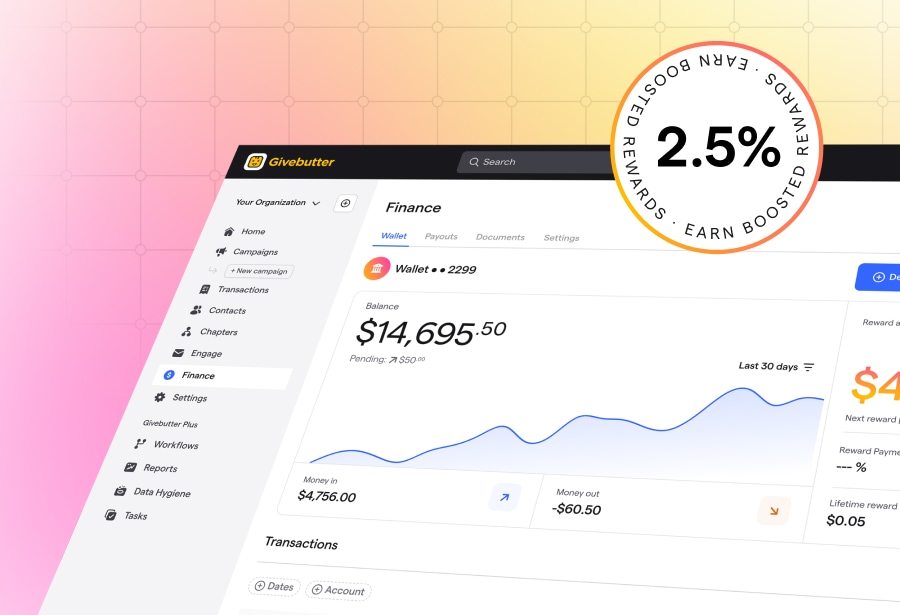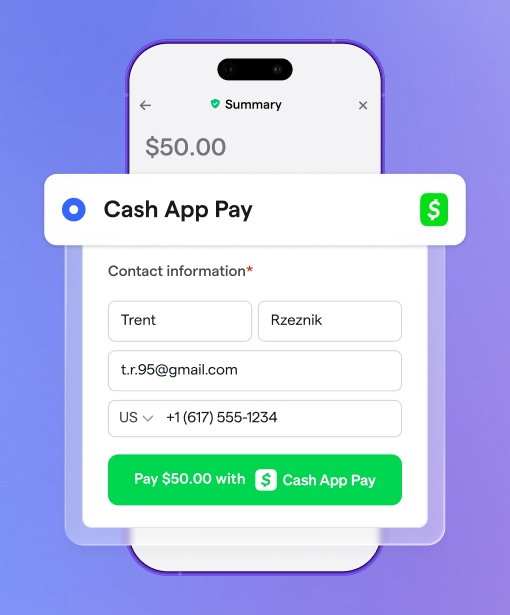Table of contents
Table of contents
Reaching the level of development director at a nonprofit is a significant professional milestone—one that comes with a unique set of opportunities and challenges. So how do you make the most of this opportunity?
In this guide, we’ll explore the qualities that make for a successful director of development. We’ll also share our top tips on how to approach your first 90 days in the role and how to continue making a difference for the long haul.
What is a development director?
A development director is the driving force behind a nonprofit’s fundraising efforts—through strategies like individual giving, grants, corporate partnerships, and more. Whether heading up a department or flying solo, they are responsible for securing funding for their entire organization.
Eager to make a positive impact, development directors frequently face challenging fundraising targets while operating with limited resources, especially at smaller organizations. This high-pressure position is known for increased turnover—in fact, 25% of development roles go unfilled each year.
What does a development director do, exactly?
The development director’s job duties will vary depending on the organization’s size, mission, goals, and fundraising initiatives. With more than 12.8 million people working in the nonprofit sector, there’s a wide range of organizations—each with its own needs and way of working.
At smaller nonprofits, development directors may work closely with just one other team member, like a grant writer or marketing coordinator. They’ll be involved in both the creation and execution of all nonprofit development and fundraising plans.
Development directors in these positions are very hands-on—preparing direct mail campaigns to long-time donors, applying for grants, securing sponsors for fundraising events, as well as overseeing the fundraising strategy and results.
In larger nonprofit organizations, the development director's role is more high-level. They focus on strategic planning while their development team members tackle everyday fundraising activities.
These development directors’ primary responsibilities include gathering and analyzing data, preparing reports for the executive director and board, and building relationships with major donors, foundations, and sponsors.
Development directors: The recipe for success
Being the director of development at a nonprofit is both rewarding and challenging, so it’s not the role for everyone. If you’re considering a development director position—or wondering whether to make it your future career goal—the following qualities could make you an ideal candidate.
Development director must-haves
✔ ️ ️ Bachelor's degree: Most nonprofit development director job descriptions will list a relevant bachelor’s degree (e.g., business administration) as a requirement.
✔️ Nonprofit fundraising experience: This isn’t an entry-level position, so you’ll need a solid foundation in fundraising and grant management experience to make a meaningful impact. The required experience varies, but many organizations look for three to five years or more.
✔️ Project and time management skills: The best development directors are masters at project planning and time management. You must be able to understand a project’s requirements, manage budgets and resources, and ensure that deadlines are met
✔️ Written and verbal communication skills: As a development director, you’ll communicate with internal and external stakeholders, so strong interpersonal skills are essential. You should be comfortable presenting to a board of directors, managing development staff, and crafting personal thank you notes to donors.
✔️ Passion: The role of a development director is busy, varied, and demanding at times. A genuine passion for your mission yields better results and makes those tougher days worthwhile.
Development director nice-to-haves
➕ Advanced degree: Many fundraising professionals pursue a master’s degree in a relevant field, like public administration or nonprofit management.
➕ Fundraising certification: Becoming a Certified Fund Raising Executive (CFRE) or receiving a professional certificate in grant writing, fundraising, or project management can help you secure your desired role.
➕ Existing donor and partner relationships: Networking and relationship-building are key functions of the job. Having existing connections makes raising those first few donations easier.
➕ Leadership skills: You’re likely to have at least one direct report, so knowing how to lead effectively and collaborate with your team is crucial.
➕ Budget management experience: As a director of development, you’ll be responsible for managing the fundraising budget, so experience with nonprofit accounting can help you make smarter financial decisions.
How to make an impact as a development director in your first 90 days
Development directors often feel pressure to make an immediate impact, but it’s easier to make a positive impact if you plan ahead and take a thoughtful approach.
When we asked experienced development directors in our community of changemakers what they found to be the most crucial part of setting themselves up for success in the first few months on the job, the overwhelming majority of respondents (87%) answered: “People: Building strong relationships with my colleagues and other stakeholders.”
The best career advice I ever got: Don't go in like a bull in a china shop. Just because you did something that worked amazingly at one place, doesn't mean it will work somewhere else. You have to understand the people, the culture, and the content before you can worry about the process or product. When you come in and immediately start changing the process, you lose respect because you are basically telling your staff that they don't know what they're doing and you know better, even though they have been there longer. — Cheri Parlaman, Director of Development at Perry Hall Christian School
To best utilize the first 90 days in your role, follow these proactive and practical steps:
Days 1-30: Become an expert on your nonprofit 👩🎓
Even if you’re familiar with your new organization’s mission and operations, stepping into the role of development director requires you to understand everything from a different angle. Use your first 30 days to gather as much information as possible from your board, staff, partners, and community members.
Meet with your executive team, host introductory sessions with staff from different departments, and schedule calls with long-term donors and partners to gain insight into recent successes and challenges.
Review your nonprofit business plan, fundraising plan, and annual reports. Familiarize yourself with the current state of the organization so you can shape it into something even better.
Days 31-60: Evaluate your software and processes 🧰
Once you have the history and context, it’s time to take a closer look at how your nonprofit currently handles fundraising.
Consider the workflows and tools your organization uses—like your donor database, grant management system, and fundraising platform—so you can make small improvements that will create significant change.
Review your current processes for all areas of fundraising—whether it’s writing grant applications, planning events, thanking donors, or running year-end campaigns. Use your findings to optimize each process.
Givebutter has so many amazing features. It has been completely thought out by its team. I have worked with bigger systems by top companies who see nonprofits as just another demographic to sell to, but Givebutter is clearly designed with nonprofits in mind. — Givebutter review, William W. (director of development)

Make data-driven decisions with Givebutter’s free CRM
Days 61-90: Create or update your nonprofit development plan 📝
As you approach the final 30 days of your first 90, you should have a clearer understanding of your mission, the fundraising landscape, and how you can make the most impact. Now it’s time to put all your knowledge into action by creating or refreshing your nonprofit development plan.
Analyze the successes and challenges from past years, then build an annual fundraising plan. Determine your budget and outline how you plan to spend it. Incorporate details on special events or fundraising programs you’ve planned based on data and donor research.
Leverage insights from your earlier conversations to craft a plan tailored specifically to your mission, goals, and community.
Top tips for staying in the development director game
The role of a development director is fast-paced and demanding, so it’s no surprise that organizations seem to move through development directors more quickly than other staff positions.
If you’re committed to this role and want to make a lasting impact, here’s how you can demonstrate your value and secure your future as a director of development professional.
- Set realistic goals 🏆 It’s common for you and your board members to have different ideas of what’s achievable. Work with your board to educate them on what’s realistic and set specific, measurable goals.
- Use data to your advantage 📊 It’s hard to dispute cold, hard numbers. Develop a habit of conducting research and using data to increase your fundraising budget (and development director salary), get approval for projects, or attract new sponsorships.
- Delegate responsibilities 💼 Almost every director of development has a task list longer than one person can handle. Delegate what you can to other team members or put forward a case for expanding your fundraising team.
- Become a leader 🎙️ You have plenty of incredible ideas and years of experience. Now it’s time to make your voice heard. Showcase your leadership skills and champion your expert insights whenever you can to guide your fundraising team toward success.
- Nurture your relationships 🎁 Maintaining strong relationships with donors, partners, and others in your network will help you consistently meet your fundraising goals.
- Invest in professional development 🎓 New social media platforms and engagement tactics pop up all the time. Stay on trends and developments in fundraising technology, marketing, donor engagement, and public relations to stay on top of your game.
Jumpstart your development director success with Givebutter
Great development directors are expert fundraisers, communicators, and leaders. It’s a rewarding role that blends fundraising and donor management skills, ideal for people who enjoy both strategic planning and direct relationship-building.
Use this guide to help you determine if this role is right for you and learn how you can make an impact in your first 90 days on the job.
Once you’ve settled in and you’re ready to level up your fundraising game, finding the right fundraising software can increase team productivity and the overall effectiveness of your campaigns.
With Givebutter’s free, all-in-one platform you can manage your donor data with a built-in CRM, set up fundraising pages, send donor communications, and analyze your impact all from one dashboard—without making a dent in your budget.
Givebutter has an easy-to-use interface, aesthetically appealing website, lots of great features (such as events, silent auctions, etc.), CRM integrations, great customer support, and workshops. — Givebutter review, Cynthia Z. (development director)
Sign up for Givebutter for free today and enjoy a smoother way to manage your fundraising, engagement, and donor management in one user-friendly place.
Nonprofit development director FAQs
Still have a burning question about all things director of development? Here are the most common ones, along with our insights:
What does a development director at a nonprofit do?
A development director’s primary responsibility is to lead the strategy and fundraising efforts for the nonprofit. The role encompasses areas such as fundraising, event management, grant management, stakeholder relations, donor engagement, and communications.
What’s another name for a director of development?
You might find a director of development referred to simply as a nonprofit development director. Other popular terms include director of development operations, chief development officer, or director of philanthropy.
How much should a development director raise?
There’s no set figure for how much a development director should raise each year. The goal is that they bring in more donations than their salary costs—ideally within the first year. In subsequent years, many directors aim to raise 2-3x more than their salary.
Does a development director write grants?
Yes, a development director may write grant applications and manage the grant process. In larger teams, they may oversee the process while junior team members handle research, writing, submission, and communication.
.svg)


.png)



%20(1).png)

















